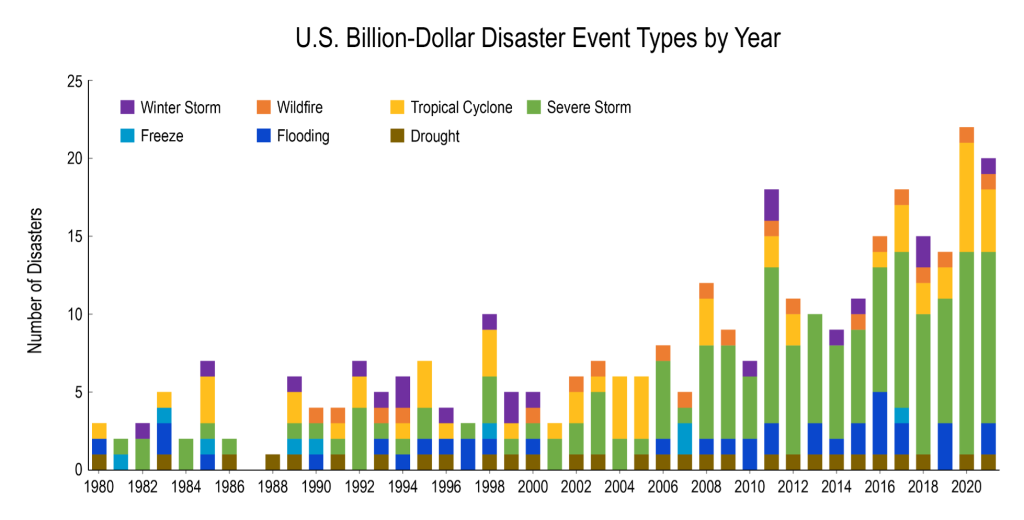The global landscape has experienced an undeniable surge in hazards over the past decade. Natural disasters, pandemics, cybersecurity events, and other crises have wrought devastation on communities worldwide, leading many to question whether the hazard environment is changing for the worse.
It also begs the question, where should resilience professionals focus? By examining specific trends, we can gain a better understanding of the current environment to formulate actions that strengthen our resilience both for today and tomorrow.
Trend #1: Increasing hazard frequency
One undeniable trend is the increase in the frequency of hazards. The past decade has witnessed a surge in climate-related events such as hurricanes, wildfires, and floods. For instance, the Atlantic hurricane season of 2020 witnessed a record-breaking number of named storms, with a total of 30, surpassing the previous record set in 2005. The western United States experienced a series of devastating wildfires in recent years, fueled by prolonged drought conditions and extreme heatwaves. Similarly, several regions across the world faced unprecedented flooding events and earthquakes, causing significant loss of life and extensive damage to infrastructure.
Cybersecurity incidents have also been on the rise. These have included data breaches and ransomware attempts from bad actors using the WannaCry and NotPetya attacks that affected millions of computers worldwide. Equally concerning is the frequency of attacks that have real-world impacts on operational systems (e.g., energy, food production, healthcare, supply chain, etc.). Also of note, phishing attacks targeting sometimes less technical public and private sector employees continue to increase.
Trend #2: Intensifying hazards
Another notable aspect of the changing hazard environment is the alarming trend of intensifying digital and physical hazards. Magnified weather events, such as hurricanes, heatwaves, and wildfires, have become more severe due to climate, urbanization, changes in risk tolerance, and other factors.
Extreme events not only wreak significant damage, disruption, and casualty on communities, but also lead to compounding incidents that make recovery even more daunting. Consider this: In February 2021, an arctic weather blast that reached down the southern United States and crippled the power grid in Texas impacted approximately 4.5 million residents as well as health care, utilities, governmental operations, and other critical infrastructures, totaling between $80 and $130 billion in direct and indirect economic losses.
The impact of man-made hazards has also intensified. Industrial accidents, chemical spills, and transportation incidents now have a higher potential for catastrophic consequences. The recent railway events involving hazardous materials highlight this phenomenon. The complexity of modern infrastructure, coupled with the interconnectedness of global supply chains, magnifies the reach and scale of these hazards, impacting multiple sectors and regions.
Furthermore, the digital landscape has similarly witnessed an increase in the sophistication of cyberattacks, data breaches, and ransomware incidents. Phishing attacks have not only increased, but also become more cunning and difficult to detect. These events not only jeopardize the security and privacy of individuals but also undermine the stability of businesses, governments, and national security.
Trend #3: Increasing impact of hazards
In the last decade, there has been a notable increase in billion-dollar disasters–events that result in significant economic losses. Several factors contribute to this trend, including climate change, population growth, and increasing vulnerability of infrastructure and communities among others.

National Centers for Environmental Information from NOAA 2023
Note the increase in billion-dollar severe weather events. Of the top ten most damaging hurricanes to hit the US, six occurred in the last decade and four of those are in the top five. Additionally, the increasing concentration of populations in vulnerable areas amplifies the potential impact of disasters. Urbanization and coastal development have placed more people and valuable assets in harm’s way making it more costly to recover and more complex and costly to respond.
The aging infrastructure in many regions also contributes to the rising costs of disasters. One example is the Oroville Dam crisis in California in 2017, where erosion and potential dam failure threatened communities downstream, and incurred substantial costs for emergency repairs and evacuation efforts.
Our increasing reliance on technology and interconnected systems also escalates the cost of disasters. Cyberattacks, for example, can disrupt critical services and infrastructure, resulting in financial losses for affected entities. The NotPetya cyberattack in 2017, which affected numerous companies worldwide, is estimated to have caused losses exceeding $10 billion.
So where do organizations focus?
As companies look to sustain themselves and attempt to thrive in this dynamic environment, where should they focus their efforts to become resilient?
1. Crisis preparedness and response planning:
Organizations must prioritize comprehensive crisis preparedness and response planning. This includes conducting thorough risk assessments, identifying vulnerabilities, and developing robust response strategies. Regular drills, simulations, and scenario-based exercises help refine response capabilities and ensure a swift and coordinated response in times of crisis. Clear communication channels, defined roles and responsibilities, and efficient decision-making are essential components of effective crisis management.
2. Stakeholder collaboration and information sharing:
Fostering collaboration and information sharing among internal and external stakeholders is paramount. Organizations should establish partnerships with government agencies, law enforcement, cybersecurity experts, public health authorities, and industry peers. Collaborative platforms, joint exercises, and information-sharing networks facilitate the exchange of critical insights, resources, and best practices. This collective approach enhances situational awareness, enables timely interventions, and strengthens overall resilience.
3. Technological advancements:
Organizations must stay ahead of the evolving technological landscape and invest in advanced tools and measures to mitigate physical and cybersecurity risks. This includes leveraging artificial intelligence and machine learning to detect and respond to cyber threats in real-time, implementing multi-layered security protocols, and regularly updating systems and software to address vulnerabilities. Further, leveraging integrated systems that aid in detecting potential physical threats or disruptions, understanding potential impacts and dynamic landscape, and creating a collaborative platform for communication, response, and recovery are important.
4. Resilient infrastructure and sustainable practices:
Developing resilient infrastructure designs and embracing sustainable practices can enhance an organization’s ability to withstand and recover from crises. This includes adopting climate-adaptive measures, incorporating redundancy and flexibility in critical systems, and diversifying supply chains to minimize disruptions. Sustainable practices, such as reducing carbon emissions, optimizing resource usage, water reuse, and promoting circular economy principles, contribute to long-term resilience while addressing environmental concerns.
5. Employee training, well-being, and incident response:
Organizations should prioritize employee training and well-being to ensure a resilient workforce capable of effectively responding to crises. This includes identifying key personnel, providing comprehensive incident response training, and equipping employees with the necessary skills and knowledge to handle crisis situations at work and home. Supporting employees’ mental and emotional well-being through counseling services, stress management initiatives, and work-life balance policies fosters resilience and maintains productivity during challenging times.
Beyond your borders
If you’re looking to multiply your positive impact and make your communities more resilient, engaging beyond the borders of your organization is crucial. After all, your success in a disaster is often directly tied to that of the communities in which you operate. Think about the benefits of bi-lateral conversations on continuous risk assessment and adaptation; engagement and empowerment of your local communities (e.g., resources, education programs, etc.); policy advocacy and governmental engagement in addressing systemic risks and sustainable infrastructure; shared innovation and research; and knowledge sharing and learning with a broader group of partners that widens everyone’s aperture.
Where do we go from here?
We go forward!
We forge ahead with a proactive mindset, embracing these focus areas to build resilience into our organizations and face the challenges of an ever-evolving hazard environment. We recognize that the trends of increasing frequency, intensity, and impact demand our attention and action. Together, with our partners, we can navigate the changing landscape, safeguard our operations, protect our assets, and ensure the well-being of our people.
But the time to act is now. By investing in resilience today, we prepare ourselves for the uncertainties of tomorrow. By rising to the occasion, harnessing our strength, and doubling down on our resolve, we build a future where resilience is our shield, and our future is brighter.


